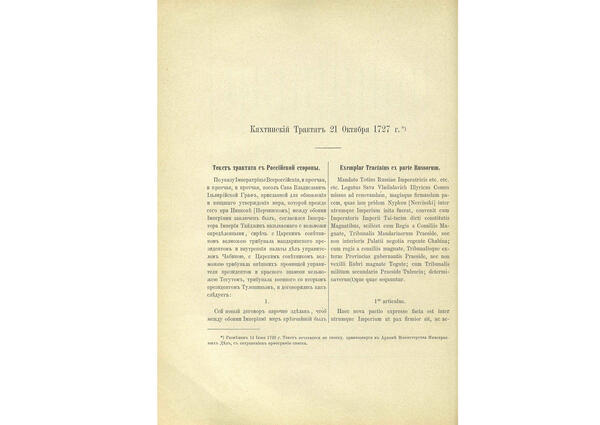The Transbaikal Regional Museum of Local Lore houses a photocopy of the “Treaty of Kyakhta” concluded in 1727 between the Russian Empire and the Qing Empire, modern China. It was signed on the bank of Kyakhta river on October 21st (November 1st by the New Style).
The document confirmed the terms of the treaties of Nerchinsk (1689) and Burinsk (1727), which regulated political, economic and border issues between the two countries.
The new treaty had 11 articles. It legally established that the Russian Spiritual Mission in Beijing would support and develop the Russian-Chinese relations. In fact, it was considered an unofficial diplomatic mission of Russia in China. The document also provided an opportunity to open an Orthodox church at the Russian Embassy Court.
The Treaty of Kyakhta determined the rules of diplomatic correspondence between the Russian Senate and the Chinese Tribunal of Foreign Relations (The Lifan Yuan). It also noted how to officially address the emperors of both countries.
In addition, the representatives of Russia and the Qing Empire agreed to stop all legal cases against border defectors, which had accumulated by 1727, and in the future to mutually extradite them without delay or investigation. Any conflicts on the border were to be resolved by the border administration with representatives from both sides.
The Treaty also reopened the Russian-Chinese caravan trade and established its rules. The number of personnel of a Russian caravan — a group of merchants and traders — could not exceed 200 people. Russia could send a caravan to Beijing every three years. In the border settlements — Nerchinsk, Tsurukaitu and on the bank of the Kyakhta River — a duty-free sale of goods was organized.
The Treaty of Kyakhta defined Russia’s relations with China for the next century. In the second half of the 19th century the countries concluded new pacts — the Treaty of Aigun in 1858, the Treaty of Tientsin in 1858 and the Treaty of Peking in 1860. They incorporated some terms from the 1727 document.
The document confirmed the terms of the treaties of Nerchinsk (1689) and Burinsk (1727), which regulated political, economic and border issues between the two countries.
The new treaty had 11 articles. It legally established that the Russian Spiritual Mission in Beijing would support and develop the Russian-Chinese relations. In fact, it was considered an unofficial diplomatic mission of Russia in China. The document also provided an opportunity to open an Orthodox church at the Russian Embassy Court.
The Treaty of Kyakhta determined the rules of diplomatic correspondence between the Russian Senate and the Chinese Tribunal of Foreign Relations (The Lifan Yuan). It also noted how to officially address the emperors of both countries.
In addition, the representatives of Russia and the Qing Empire agreed to stop all legal cases against border defectors, which had accumulated by 1727, and in the future to mutually extradite them without delay or investigation. Any conflicts on the border were to be resolved by the border administration with representatives from both sides.
The Treaty also reopened the Russian-Chinese caravan trade and established its rules. The number of personnel of a Russian caravan — a group of merchants and traders — could not exceed 200 people. Russia could send a caravan to Beijing every three years. In the border settlements — Nerchinsk, Tsurukaitu and on the bank of the Kyakhta River — a duty-free sale of goods was organized.
The Treaty of Kyakhta defined Russia’s relations with China for the next century. In the second half of the 19th century the countries concluded new pacts — the Treaty of Aigun in 1858, the Treaty of Tientsin in 1858 and the Treaty of Peking in 1860. They incorporated some terms from the 1727 document.



